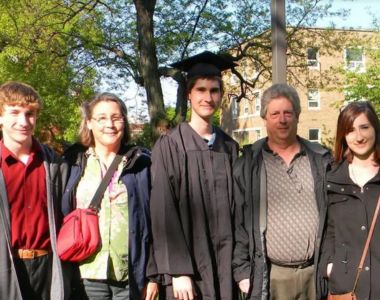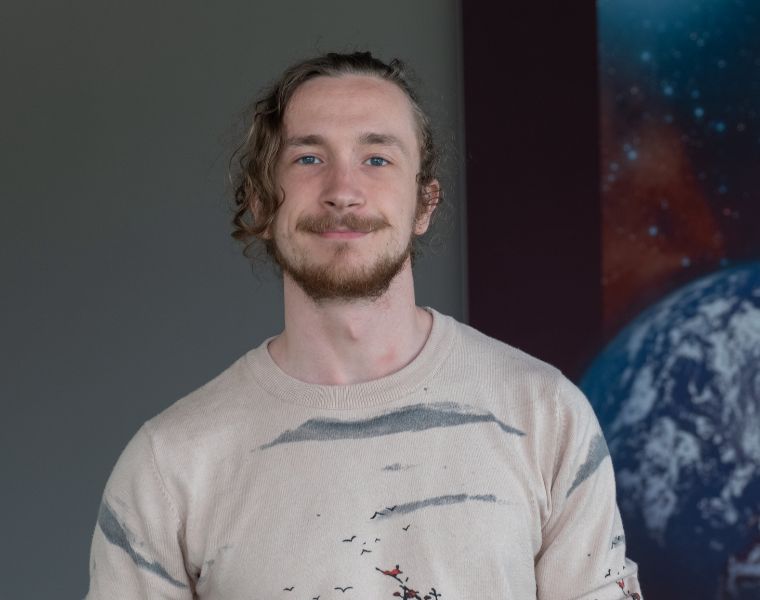Over 60 years ago, William Roland Dawson (CIT ’62) earned a PhD at Case Institute of Technology. Today, his grandson William Bernardoni continues the family tradition of studying at Case Western Reserve University, where he is expected to graduate with a PhD in mathematics in 2025.
For Bernardoni, his love for mathematics began during his undergraduate experience at John Hopkins University, where he studied computer science with interests in computational linguistics and robotics. There, he began a second major in mathematics and worked in robotics and machine translation labs to create new techniques to automatically translate more than 1,600 low-resource languages.
The only problem? The math wasn’t there for most of the methods his team wanted to try.
“We wanted to augment our translations with grammar, semantic and syntactic data, but those all have very specific tree-like structures, and we couldn’t find faithful representations of those structures that we could use the latest and greatest machine translation techniques on,” Bernardoni said. “This was the first time I ran into the ‘boundary’ of math, and it made me obsessed with math.”
Since then, Bernardoni has applied this passion at NASA Glenn Research Center, where he participated twice as a summer intern in the Space Communications and Navigations Internship Project (SIP)—a 10-week program in which high school, undergraduate and graduate students work firsthand with NASA mentors on different projects specializing in various areas of space communication and navigation.
Specifically, he worked with a team of undergraduate and graduate students on the High Relate Delay/Disruption Tolerant Networking (HDTN) project to create a “space internet” by mathematically modeling deep space satellite networks and developing algorithms to automatically route through them.
“Right now if you want to send a message to the moon, NASA has a team of people working 24/7 to manually route that message through our satellites to the moon,” Bernardoni said. “The goal is to have a moon base within our lifetime, and if we have people living on the moon, then there will be a lot of messages back and forth to route, so we need a way to automate it.”
Read on to learn more about Bernardoni’s studies and his research at NASA.
Answers have been edited for clarity and length.
1. What led you to attend CWRU? What do you hope to accomplish through your studies?

My brother and sister went to [Case Western Reserve University] as undergraduates, and both got math degrees and loved the department, so there is a lot of fondness for CWRU in my family. I applied to several programs, but CWRU was the one I got into on that application cycle, and it felt like a great fit with the flexibility of the department, the great faculty here, and my family’s great experiences with the math department.
For my studies, I am hoping that by generalizing methods from algebraic and tropical geometry to work over arbitrary idempotent semirings, it will allow us a whole host of new algorithms and approaches to difficult problems in computer science and in real life. Many strange combinatorial problems (such as satellite networking) can be expressed as solving polynomial equations over idempotent semirings; the issue is that we don’t know how to do that too well, so any progress we make on new methods for solving those equations gives us new methods to solve hundreds and hundreds of difficult problems.
2. How have your experiences at CWRU contributed to your academic and professional growth?
The faculty at [Case Western Reserve] is amazing. They are incredibly kind and supportive, and have always been willing to meet and talk about my research and suggest directions to look into. I have nothing but overwhelming positive feelings and experiences with the math faculty at CWRU.
3. What challenges did you face during your internship, and how did you overcome them?
It turns out that creating a space internet is pretty difficult. Everything in space is moving and every message depends on your line of sight. So you only have certain windows in time that your satellites can talk, and everything in space is very far away so messages can take on the order of minutes or hours. On Earth, if you want to send a message across the planet and back, it would take on the order of 200 milliseconds; if you want to send a message to Mars and back, it could take on the order of 10 to 40 minutes.
Math is also very collaborative, but it can be very difficult to communicate, even among mathematicians. Each student in the internship came from very different math backgrounds and fields and had very different perspectives on the problems we were looking at. While I was looking into semiring approaches, other students were looking into sheaves (a tool for systematically tracking data such as sets, abelian groups and rings attached to open sets of a topological space), or purely tropical methods.
4. What valuable lessons or takeaways did you gain from your internship?
The main lesson I learned is that research alone isn’t worth much if you cannot communicate it. The task of a researcher isn’t just to find out the answer to a problem, but to find out how to communicate that answer so that other people can understand and build on your work.
Math has a large image problem—many people have been scarred by truly awful math experiences growing up and have a hostile opinion of math. And, for the most part, we aren’t giving them any reason not to. When I tell people I am doing a PhD in math, their mental image is that I am doing complicated integrals—I haven’t done an integral in years. I hated calculus, but I think math is truly beautiful. We need to do a better job of showing people the beautiful parts of math, and that it’s more than just integrals and solving for x.
5. What are your career aspirations beyond CWRU?
I entered [Case Western Reserve University] with the broad idea that I wanted to do tropical geometry or representation theory, and now I have a specific research direction. I am in contact with some world experts in networking and communications, and I am incredibly passionate about my niche research area!
I love research, and I love the research I do. I will be applying for postdocs and seeing if I am able to stay in academia.
6. Is there anything else you’d like to share?
I would heavily encourage both graduates and undergraduates from any research area to look into the NASA SIP and NASA OSTEM internships. There are tremendous opportunities that are not just limited to STEM [students]. At the internship, there were marketing, photography and animation interns, technical writers, chemists, mathematicians, mechanical engineers [and other] internship roles for any field. It really is a tremendous opportunity.

